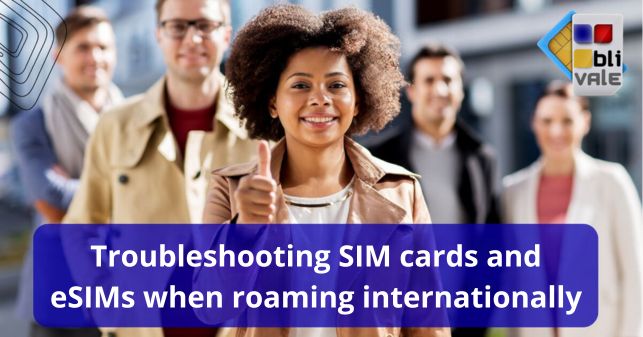Are you having problems with your SIM or eSIM card while traveling abroad? Don't worry, we'll take care of it! In this article, we will provide you with some essential tips to troubleshoot and fix any problems you may encounter with your SIM or eSIM card while roaming internationally. By following these steps, you can ensure a smooth and uninterrupted mobile experience while traveling.
Activate Your SIM Card or eSIM Correctly
The first step in troubleshooting any SIM card or eSIM issue is to ensure that it has been activated correctly. When purchasing a new SIM card or enabling an eSIM, make sure to follow the provided instructions carefully. This typically involves inserting the physical SIM card into your device's SIM tray or scanning a QR code to activate the eSIM.
If you are unsure of the activation process, as some BLIVALE customers do, please contact us for assistance. We can walk you through the necessary steps and resolve any concerns you may have.
Verify Network Compatibility
Before traveling internationally, it's crucial to verify that your device is compatible with the network frequencies used in your destination country. Different countries utilize various network technologies such as GSM, CDMA, or LTE. If your device does not support the network frequencies used by the local carriers at your travel destination, you may face connectivity issues.
However, BLIVALE eSIM and SIM Cards connect and are compatible with all networks in the world, whether they are in 3G or 4G or 5G.
Restart Your Device
If you're experiencing difficulties with your SIM card or eSIM connection while roaming internationally, try restarting your device first before taking any further action. Often, minor software glitches can cause temporary disruptions in connectivity. Restarting your device helps refresh the system and can resolve such issues.
To restart your device, simply power it off completely and then turn it back on after a few seconds (we recommend counting at least to 10 or waiting at least 10 seconds). Once it reboots, check if the SIM card or eSIM is functioning correctly. If the problem persists, proceed to the next troubleshooting step.
Check Airplane Mode
Another simple yet effective troubleshooting step is to check whether Airplane Mode is enabled on your device. When Airplane Mode is activated, all wireless connections, including cellular data, are disabled. This feature is particularly useful when traveling by air as it prevents interference with aircraft communication systems.
However, sometimes Airplane Mode may be accidentally left enabled after a flight or inadvertently turned on while navigating through your device's settings. If you're experiencing connectivity issues with your SIM card or eSIM, ensure that Airplane Mode is disabled in your device settings before proceeding further.
Update Your Device Software
Before you leave on your trip, keep your device's software up to date. It is essential for optimal performance and compatibility with various network technologies. Software updates often include bug fixes, security patches, and enhancements that can address known issues with SIM and eSIM cards.
To update your device's software, go to the settings menu and look for the "Software Update" or similar option. Check for any available updates and follow the prompts to install them. After updating your device software, check if the SIM card or eSIM issues are resolved.
Never update the software and APPs while traveling
In order not to consume data with the BLIVALE SIM Card and eSIM, never update the software and APPs while traveling, you avoid consuming data that is useful to you on your journey. Don't do it even if you have an unlimited plan, always do it only before you leave.
Once software and APP are updated block the updates and keep them locked during the journey.
Reset Network Settings
If none of the above steps have resolved your SIM card or eSIM problems while roaming internationally, you can try resetting your network settings as a next troubleshooting measure. Resetting network settings removes any saved Wi-Fi passwords, VPN configurations, Bluetooth pairings, and cellular network preferences from your device.
To reset network settings on most devices:
- Go to the settings menu.
- Look for “General” or “System.”
- Find the "Reset" option.
- Select “Reset Network Settings.”
After resetting your network settings, reconnect to your mobile data network or Wi-Fi and check if the SIM card or eSIM is functioning correctly.
Note that you may need:
- re-enter your Wi-Fi passwords
- other network details after performing this reset
- check that the APN of the BLIVALE SIM Card and eSIM is set correctly as per the communication received.
Contact BLIVALE if you still have inconvenience
If you have exhausted all the troubleshooting steps and are still having problems with your SIM or eSIM card while roaming internationally, it's time to contact BLIVALE for further assistance. We have the expertise and resources to diagnose and resolve complex connectivity issues.
Contact the customer support of your mobile phone service provider via the APP or via WhatAPP. Explain the problem in detail, provide any error messages you may have received, and tell them what troubleshooting steps you've already taken. We will walk you through further troubleshooting steps or initiate further investigation of the issue.
Concluding
Don't let SIM or eSIM card problems ruin your trip! By following these troubleshooting tips, you can ensure a smooth mobile experience when roaming internationally. Activate successfully, check network compatibility, restart device, check airplane mode, update software, reset network settings if needed, contact BLIVALE for assistance when needed.
With BLIVALE stay connected with ease wherever your travels take you!









